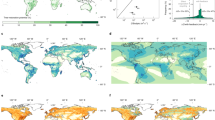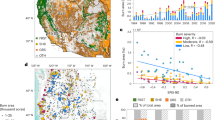Abstract
The recent climate-exacerbated mountain pine beetle infestation in the Rocky Mountains of North America has resulted in tree death that is unprecedented in recorded history. The spatial and temporal heterogeneity inherent in insect infestation creates a complex and often unpredictable watershed response, influencing the primary storage and flow components of the hydrologic cycle. Despite the increased vulnerability of forested ecosystems under changing climate1, watershed-scale implications of interception, ground evaporation, and transpiration changes remain relatively unknown, with conflicting reports of streamflow perturbations across regions. Here, contributions to streamflow are analysed through time and space to investigate the potential for increased groundwater inputs resulting from hydrologic change after infestation. Results demonstrate that fractional late-summer groundwater contributions from impacted watersheds are 30 ± 15% greater after infestation and when compared with a neighbouring watershed that experienced earlier and less-severe attack, albeit uncertainty propagations through time and space are considerable. Water budget analysis confirms that transpiration loss resulting from beetle kill can account for the relative increase in groundwater contributions to streams, often considered the sustainable flow fraction and critical to mountain water supplies and ecosystems.
This is a preview of subscription content, access via your institution
Access options
Subscribe to this journal
Receive 12 print issues and online access
$209.00 per year
only $17.42 per issue
Buy this article
- Purchase on Springer Link
- Instant access to full article PDF
Prices may be subject to local taxes which are calculated during checkout





Similar content being viewed by others
References
Anderegg, W. R. L., Kane, J. M. & Anderegg, L. D. L. Consequences of widespread tree mortality triggered by drought and temperature stress. Nature Clim. Change 3, 30–36 (2012).
Colorado State Forest Service, 2012 Report on the Health of Colorado’s Forests (CSFS, (2013).
Hubbard, R. M., Rhoades, C. C., Elder, K. & Negron, J. Changes in transpiration and foliage growth in lodgepole pine trees following mountain pine beetle attack and mechanical girdling. For. Ecol. Manage. 289, 312–317 (2013).
Wulder, M. A., Dymond, C. C., White, J. C., Leckie, D. G. & Carroll, A. L. Surveying mountain pine beetle damage of forests: A review of remote sensing opportunities. For. Ecol. Manage. 221, 27–41 (2006).
Biederman, J. A. et al. Multiscale observations of snow accumulation and peak snowpack following widespread, insect-induced lodgepole pine mortality. Ecohydrology 7, 150–162 (2014).
Mikkelson, K. M. et al. Bark beetle infestation impacts on nutrient cycling, water quality and interdependent hydrological effects. Biogeochemistry 115, 1–21 (2013).
Clow, D. W., Rhoades, C., Briggs, J., Caldwell, M. & Lewis Jr, W. M. Responses of soil and water chemistry to mountain pine beetle induced tree mortality in Grand County, Colorado, USA. Appl. Geochem. 26, S174–S178 (2011).
Brown, M. G. et al. Evapotranspiration and canopy characteristics of two lodgepole pine stands following mountain pine beetle attack. Hydrol. Process. http://dx.doi.org/10.1002/hyp.9870 (2013).
Maness, H., Kushner, P. J. & Fung, I. Summertime climate response to mountain pine beetle disturbance in British Columbia. Nature Geosci. 6, 65–70 (2013).
Pypker, T. G. et al. Can carbon isotopes be used to predict watershed-scale transpiration? Wat. Resour. Res. 45, W00D35 (2009).
Stednick, J. D. Monitoring the effects of timber harvest on annual water yield. J. Hydrol. 176, 79–95 (1996).
Sueker, J. K., Ryan, J. N., Kendall, C. & Jarrett, R. D. Determination of hydrologic pathways during snowmelt for alpine/subalpine basins, Rocky Mountain National Park, Colorado. Wat. Resour. Res. 36, 63–75 (2000).
Clow, D. W. et al. Ground water occurrence and contributions to streamflow in an alpine catchment, Colorado Front Range. Ground Wat. 41, 937–950 (2003).
Mikkelson, K. M., Dickenson, E. R. V., Maxwell, R. M., McCray, J. E. & Sharp, J. O. Water-quality impacts from climate-induced forest die-off. Nature Clim. Change 3, 218–222 (2013).
Hooper, R. P. Diagnostic tools for mixing models of stream water chemistry. Wat. Resour. Res 39, 1055–1067 (2003).
Tetzlaff, D., Malcolm, I. A. & Soulsby, C. Influence of forestry, environmental change and climatic variability on the hydrology, hydrochemistry and residence times of upland catchments. J. Hydrol. 346, 93–111 (2007).
Jung, H., Hogue, T. & Rademacher, L. Impact of wildfire on source water contributions in Devil Creek, CA: Evidence from end-member mixing analysis. Hydrol. Process. 23, 183–200 (2009).
Adams, H. D. et al. Ecohydrological consequences of drought- and infestation-triggered tree die-off: insights and hypotheses. Ecohydrology 5, 145–159 (2012).
Pugh, E. & Gordon, E. A conceptual model of water yield effects from beetle-induced tree death in snow-dominated lodgepole pine forests. Hydrol. Process. 27, 2048–2060 (2013).
Beudert, B., Klöcking, B. & Schwarze, R. Grosse Ohe: Impact of bark beetle infestation on the water and matter budget of a forested catchment. For. Hydrol. Res. Ger. Russ. 41–63 (2007).
Braddock, W. & Cole, J. Geologic Map of Rocky Mountain National Park and Vicinity, Colorado (US Geol. Surv. Map I-1973, 1990).
Rocky Mountain National Park Vegetation Project Field Plot Locations (US Natl Park Serv., 2006).
National Operational Hydrologic Remote Sensing Centre, Snow Data Assim. Syst. (SNODAS) Data Prod. NSIDC, [April 1, 2012] (National Snow and Ice Data Center, (2004).
Hubbard, R. M., Bond, B. J. & Ryan, M. G. Evidence that hydraulic conductance limits photosynthesis in old Pinus ponderosa trees. Tree Physiol. 19, 165–172 (1999).
Collins, B. J., Rhoades, C. C., Hubbard, R. M. & Battaglia, M. A. Tree regeneration and future stand development after bark beetle infestation and harvesting in Colorado lodgepole pine stands. For. Ecol. Manage. 261, 2168–2175 (2011).
Rhoades, C. C. et al. Biogeochemistry of beetle-killed forests: Explaining a weak nitrate response. Proc. Natl Acad. Sci. USA 110, 1756–60 (2013).
Knight, D. H., Fahey, T. J. & Running, S. W. Water and nutrient outflow from contrasting lodgepole pine forests in Wyoming. Ecol. Monogr. 55, 29–48 (1985).
Mikkelson, K. M. et al. Mountain pine beetle infestation impacts: Modeling water and energy budgets at the hill-slope scale. Ecohydrology 6, 64–72 (2013).
Fishman, M. J. Methods of analysis by the US Geological Survey National Water Quality Laboratory: Determination of Inorganic and Organic Constituents in Water and Fluvial Sediments, vol. 93–125 (US Geol. Surv., 1993).
Sibold, J. S. et al. Influences of secondary disturbances on lodgepole pine stand development in Rocky Mountain National Park. Ecol. Appl. 17, 1638–1655 (2007).
Acknowledgements
This material is based on work supported by the National Science Foundation under Grant No. WSC-1204787, the USGS-National Institute of Water Resources under Grant No. 2011CO245G Subaward G-2914-1 and through the Water, Energy, and Biogeochemical Budgets program and USGS/NPS Partnership program.
Author information
Authors and Affiliations
Contributions
L.A.B. and R.M.M. conceived the study, L.A.B. and D.W.C. collected and analysed the data, and L.A.B., R.M.M., D.W.C. and J.E.M. interpreted results and contributed to writing.
Corresponding authors
Ethics declarations
Competing interests
The authors declare no competing financial interests.
Supplementary information
Rights and permissions
About this article
Cite this article
Bearup, L., Maxwell, R., Clow, D. et al. Hydrological effects of forest transpiration loss in bark beetle-impacted watersheds. Nature Clim Change 4, 481–486 (2014). https://doi.org/10.1038/nclimate2198
Received:
Accepted:
Published:
Issue Date:
DOI: https://doi.org/10.1038/nclimate2198
This article is cited by
-
Tree insect pests and pathogens: a global systematic review of their impacts in urban areas
Urban Ecosystems (2023)
-
Mechanisms of woody-plant mortality under rising drought, CO2 and vapour pressure deficit
Nature Reviews Earth & Environment (2022)
-
Biogeochemical causes of sixty-year trends and seasonal variations of river water properties in a large European basin
Biogeochemistry (2021)
-
Bark Beetle Outbreaks in Europe: State of Knowledge and Ways Forward for Management
Current Forestry Reports (2021)
-
Water colour and climate
Nature Climate Change (2020)



